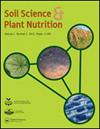Polyphosphate polymerizing and depolymerizing activity of VTC4 protein in an arbuscular mycorrhizal fungus
IF 1.8
4区 农林科学
Q3 ENVIRONMENTAL SCIENCES
引用次数: 2
Abstract
ABSTRACT Arbuscular mycorrhizal (AM) fungi form symbiotic associations with land plants and supply soil minerals including phosphorus to their hosts. AM fungi accumulate polyphosphate (polyP), a linear phosphate polymer, in their mycelia, which functions in phosphorus storage and translocation. In the budding yeast Saccharomyces cerevisiae, it has been demonstrated that the vacuolar transporter chaperone 4 (VTC4) protein, a subunit of the VTC complex, is responsible for polyP synthesis. Here, we conducted a comprehensive survey of VTC proteins in eight AM fungal genomes by Blast analysis and characterized the biochemical properties of the Rhizophagus irregularis VTC4. The genomes of AM fungal species encode VTC1, VTC2, and VTC4. The recombinant protein RiVTC4* (RiVTC4183–474) containing the catalytic tunnel domain was expressed in E. coli cells and purified. RiVTC4* is capable of catalyzing polyP polymerization using ATP as a substrate. Pyrophosphate enhanced polyP-polymerizing activity >10-fold. RiVTC4* exhibited maximum activity at neutral pH and required divalent metal ions, preferentially Mn2+. In the presence of high concentrations of ADP, the reverse reaction (the regeneration of ATP from polyP) by RiVTC4* occurred. In the range of 0.2–5 mM ADP, polyP depolymerization by the reverse reaction was observed at the ATP/ADP ratio of less than 2–5. These results suggest that AM fungal VTC4 not only synthesizes polyP but also regenerates ATP from polyP and ADP, which has potential implications for the modulation of polyP and ATP levels in AM fungi.丛枝菌根真菌中VTC4蛋白的聚磷酸盐聚合和解聚活性
丛枝菌根真菌(AM)与陆地植物形成共生关系,为寄主提供包括磷在内的土壤矿物质。AM真菌在其菌丝中积累聚磷酸盐(polyP),这是一种线性磷酸盐聚合物,具有磷的储存和转运功能。在出芽酵母酿酒酵母中,已经证明液泡转运蛋白伴侣蛋白4 (VTC4)是VTC复合物的一个亚基,负责polyP的合成。本研究利用Blast分析方法对8个AM真菌基因组的VTC蛋白进行了全面分析,并对不规则根噬菌VTC4的生化特性进行了表征。AM真菌物种的基因组编码VTC1、VTC2和VTC4。含有催化隧道结构域的重组蛋白RiVTC4* (RiVTC4183-474)在大肠杆菌细胞中得到表达和纯化。RiVTC4*能够以ATP为底物催化聚酰亚胺聚合。焦磷酸盐使聚合物聚合活性提高了10倍以上。RiVTC4*在中性pH下表现出最大的活性,需要二价金属离子,优先是Mn2+。在高浓度ADP存在的情况下,RiVTC4*发生了逆反应(从息肉中再生ATP)。在0.2-5 mM ADP范围内,当ATP/ADP比小于2-5时,可观察到聚丙烯发生逆反应解聚。这些结果表明AM真菌VTC4不仅可以合成polyP,还可以从polyP和ADP中再生ATP,这可能对AM真菌中polyP和ATP水平的调节有潜在的影响。
本文章由计算机程序翻译,如有差异,请以英文原文为准。
求助全文
约1分钟内获得全文
求助全文
来源期刊

Soil Science and Plant Nutrition
农林科学-农艺学
CiteScore
4.80
自引率
15.00%
发文量
56
审稿时长
18-36 weeks
期刊介绍:
Soil Science and Plant Nutrition is the official English journal of the Japanese Society of Soil Science and Plant Nutrition (JSSSPN), and publishes original research and reviews in soil physics, chemistry and mineralogy; soil biology; plant nutrition; soil genesis, classification and survey; soil fertility; fertilizers and soil amendments; environment; socio cultural soil science. The Journal publishes full length papers, short papers, and reviews.
 求助内容:
求助内容: 应助结果提醒方式:
应助结果提醒方式:


